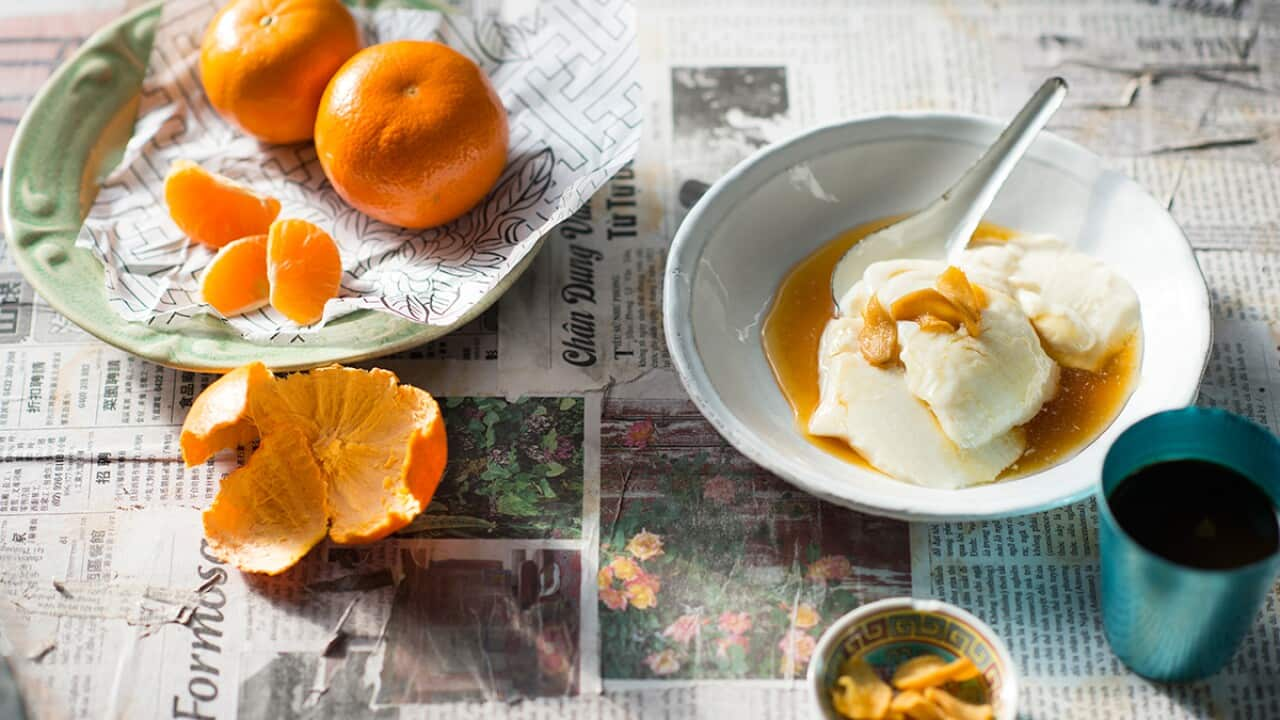On a hot summer's day in Melbourne, I remember sitting in our backyard, cooling down with a bowl of tofu hwa as my feet dangled in the above-ground pool.
Perhaps the image would be better with a cheek of mango, cut in a criss-cross fashion or a wedge of refreshing red watermelon in my little hands – but no, my hands cupped a small bowl of sweetened tofu.
With many Western Aussies now welcoming tofu into their flexible diets, the internet is flooded with tofu recipes in many unusual renditions us Asian-Australian kids never grew up with. Search online and you will see tofu pressed with bricks to remove water, baked in the oven and even ‘blackened’ under the grill with Tex-Mex spices – all these recipes may be pictorially beautiful but I also cringe at them because I am a purist and traditionalist when it comes to ingredients I grew up eating.
But if you thought tofu sweetened up with sugar and embellished with red bean paste and even bubble tea was just another modern-day fad, think again. Welcome to the world of tofu hwa (also known as douhua or ).
Loosely translated, tofu hwa means tofu flower. It might have been given this picturesque name because of the delicate image of tofu floating in a bowl of sugar syrup. If you are a fan, you would have seen ladies pushing dim sum trolleys around your favourite Cantonese restaurant during a bustling yum cha service in Australia. The giant vat on the trolley comes out at the end of the yum cha session and – if you are not quick – you may miss your chance to enjoy one of the greatest dim sum items out there: silken tofu. It sits in a wooden container, is delicately scooped out with a spoon and served with a thick syrupy sauce made of ginger, water and sugar – it's much loved by dim sum fans. The joy of the dish comes down to the combination of silky tofu plus sugar syrup, which is boiled down to an unctuous liquid, reminiscent of the same consistency of a well-made French .
Although tofu hwa is commonly served hot (with the ginger warming your body during winter), my favourite version is consumed slightly chilled.
When the tofu slides down my throat – slippery, shiny and velvety in texture – it gives me instant relief from the summer heat. Or it can quash sugar cravings I have in the middle of the night. It's luscious.
With tofu hwa dating back to the , this dish has been open to many interpretations as it made its way around Asia.
In Northern China, tofu hwa is served with soy sauce; in Sichuan, it comes with fiery red chilli oil and Sichuan pepper as an instant wake-up call for breakfast.
Loosely translated, tofu hwa means tofu flower. It might have been given this picturesque name because of the delicate image of tofu floating in a bowl of sugar syrup.
In Taiwan, the tofu hwa I remember eating on the streets came with many extras – tapioca balls, taro mochi and also red bean paste. When I was a child, my mum once tried serving me a savoury version that she grew up eating and it did not sit very well with nine-year-old me. It had pickled cabbage, fried Chinese doughnuts, coriander and pork floss (which I as a child). "What is this mum? Where are my Coco Pops for breakfast? Why, mum, why?"
I did, however, love my mum’s peanut version and still do. Instead of a ginger-sugar syrup, a sweetened peanut soup surrounds the silken tofu in all its glistening and – yes, I will say it – slimy glory.
Many Asian desserts may not have the same charm and indulgence as Western sweets (like chocolate and buttery pastries), but the intense sweetness that bathes the tofu is hard to pass – especially after an oily and rich yum cha lunch, right? What makes tofu hwa even better is that it is quick and easy to make: supermarket silken tofu and a simple sugar syrup come together to provide a heavenly dessert in a flash.
There are many tofu hwa recipes online encouraging home cooks to make their very own tofu from scratch – but I don’t recommend it. A few years back, when I was testing recipes for my first book, , I relished the challenge and attempted my own tofu. The process seemed simple enough: use freshly grated ginger juice and mix it into fresh soybean milk. Unfortunately, the recipe is not as straightforward as it sounds and it was definitely not fun to end up with soy milk flying out of my blender, soybean dust all over the kitchen and, finally, very watery tofu as a result.
After learning from my mistakes, I have not attempted to make tofu hwa from scratch. I continue to enjoy the dessert with silken tofu from the supermarket – especially at the end of a warm day. Any jiggly and soft tofu works incredibly well in this dish and I am thankful that I can whip up tofu hwa in a matter of seconds when that 3pm or 12am sugar craving strikes again – and it will.
Taken with tofu

Mushroom and tofu pho









